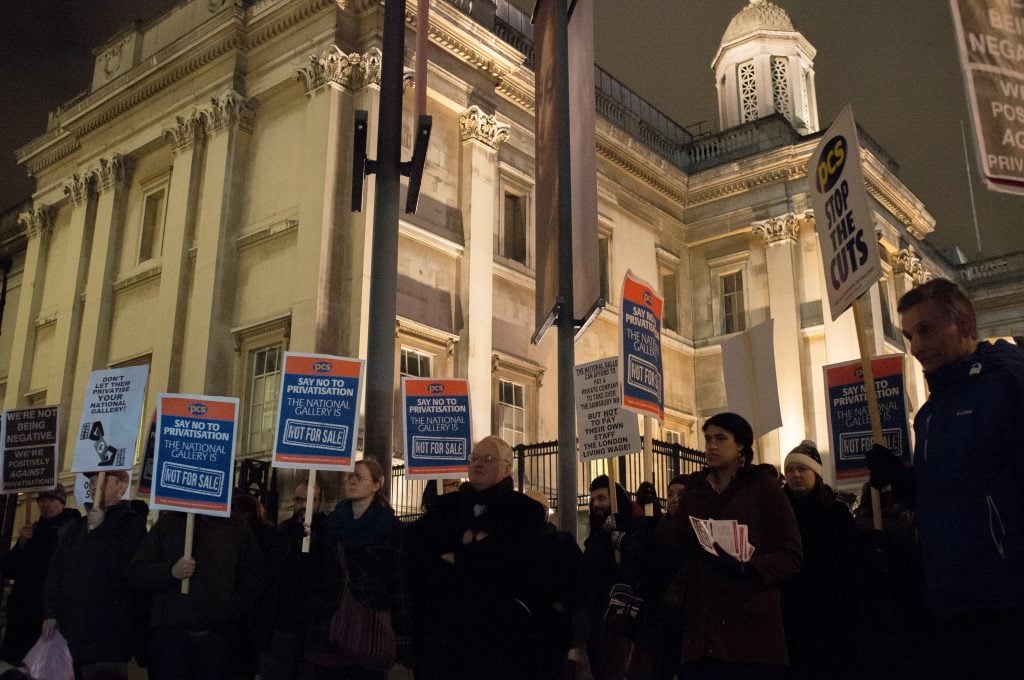Art & Exhibitions
Staffing Crisis at London’s National Gallery
Did internal troubles push out director Nicholas Penny?

Did internal troubles push out director Nicholas Penny?

London’s National Gallery could be facing extended worker strikes after the institution announced it will be privatizing some of its services. This could prove greatly disturbing for Britain’s second most popular art museum, which welcomes over six million visitors every year.
PCS (Public and Commercial Services), one of the unions that represents its staff, opposes plans to privatize the museum’s front of house team, whose tasks involve looking after the paintings and the public, providing information about the artworks and exhibitions, and supervising schools visits. Discussions with senior management have been ongoing since mid-2014, but appear to have hit a deadlock. According to a PCS representative artnet News spoke to, most workers are now in favor of the strikes.
PCS is currently holding a secret ballot, which will end on Friday. If the vote in favor of industrial action wins, strikes could begin as early February.
“Privatization often implies that the private company, driven by the desire to make profits, will seek to cut costs,” Richard Simcox, PCS’s national press officer, told artnet News. “And the biggest cost of any organization is its staff, so we are concerned that they’d be looking to cut the numbers of staff.” Simcox explains that, while this is of course unfortunate for any staff that would then be out of work, the larger implication is a potential downward turn in service quality to the National Gallery’s visitors. If staff are spread too thin, the safety of artworks could too be at risk.
The National Gallery has denied its employees were facing such a threat. In a statement sent to artnet News, it said that the privatization “is a transfer process” and that “there will be no redundancies as a result of this undertaking.”
Terms Being Contested by PCS
As required by the Transfer of Undertakings (Protection of Employment) Regulations, upon being transferred to a private company, staff would keep the terms of their employment. But the terms themselves are being contested by PCS, as they claim that the National Gallery is the only museum in London which doesn’t pay its staff the living wage, currently set at £9.15 per hour.
“Last year, the museum management promised that they would introduce the living wage, and then went back on that pledge, and then they said that they would introduce it this year, but at last year’s rate, which wouldn’t make it the living wage anymore,” Simcox told artnet News. “Staff feel really let down by that fact. They provide a very important service for one of the UK’s major cultural attractions, only second in yearly visits to the British Museum, and they feel, quite rightly, that they deserve to be rewarded for the work they do.”
With negotiations leading nowhere, a museum trustee told the Guardian‘s Polly Toynbee that the private security company CIS was brought in during the Rembrandt exhibition to give the “gallery staff a fright.” At the very least, working conditions are said to have taken a downward turn in that particular wing. Among reported changes was the removal of chairs within the galleries in which museum staff were allowed to rest during their shifts.
Government funding for the museum has decreased by 15 percent since 2011, and management is hoping to offset the cuts by increasing revenue from ticketed events, retail, and commercial activities. “In order to do this we need to be able to guarantee the provision of essential security and services,” a museum spokesperson told the Guardian last summer. “It is for these reasons that the National Gallery is seeking a partner to manage the provision of some of its visitor-facing services. This is an approach that has been adopted by many other UK galleries and museums.”
London Living Wage
According to a letter sent by outgoing director Nicholas Penny on January 9, 2015, the National Gallery offered a “salary in the region of £19,500 (plus overtime), far in excess of the London Living Wage minimum, in return for greater flexibility and the option for PCS to work with VSS managers to design a new roster for everyone.” But this was turned down by PCS.
Some have started to speculate that Penny’s abrupt decision to retire after six successful years as director might well be linked to these internal struggles and a rift between the museum’s board of trustees and its upper level management.
“The timing of Nicholas Penny’s departure does seem hugely coincidental,” Simcox told artnet News. “Just over a year ago, a paper that went to the board of trustees said that the senior management team didn’t see the need for privatizing the staff, that they felt that they could actually improve the services by investing in staff, training, and development. And suddenly, out of the blue, they announced that, actually, they were minded to outsource or privatize the visitor services instead. And it was around that same time that Nicholas Penny announced that he would be leaving. So we have actually asked the Culture Select Committee at the House of Commons if they would consider an investigation into what’s happened there.”